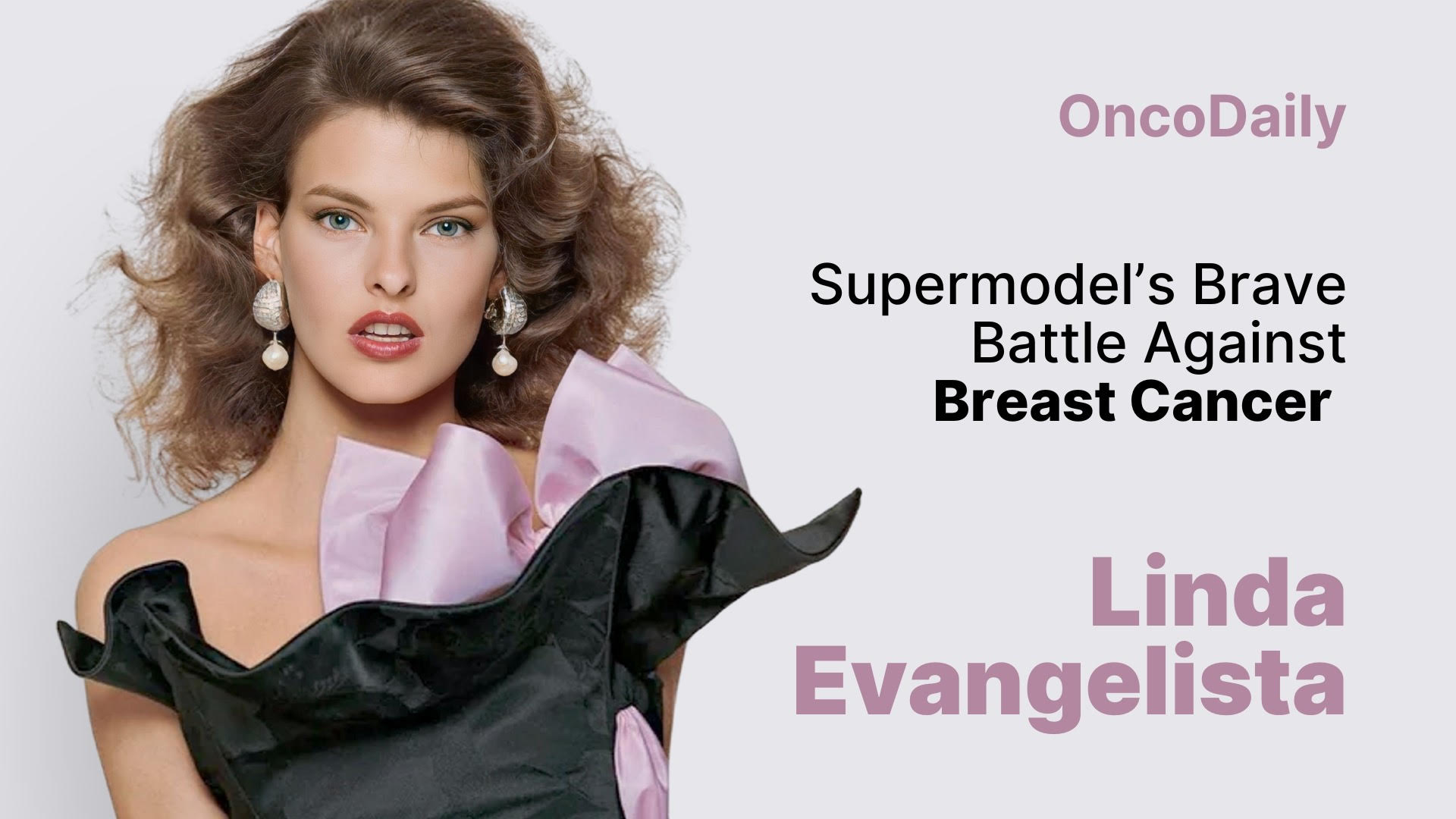Linda Evangelista, one of the greatest supermodels of the 1990s and a fashion icon known worldwide, has bravely shared her private battle with breast cancer. Diagnosed in 2018 during a routine mammogram, she underwent aggressive treatment including a bilateral mastectomy. Despite facing a recurrence in 2022, Evangelista’s resilience and determination continue to inspire many. Her story highlights the importance of early detection, strength, and hope in the fight against cancer.
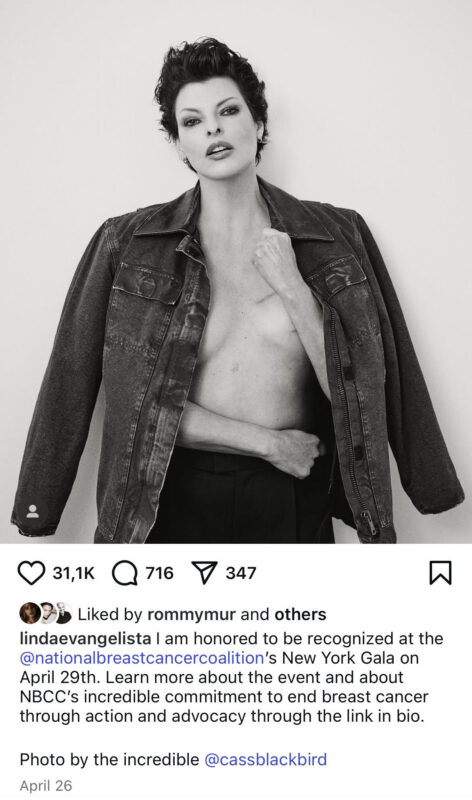
How Did Linda Evangelista Get Diagnosed with Breast Cancer?
Linda Evangelista was first diagnosed with breast cancer in December 2018 after it was detected during her annual mammogram screening. The mammogram revealed abnormal results, prompting further imaging and a biopsy, which confirmed the diagnosis. Evangelista has emphasized the importance of regular mammograms, noting that her cancer was found early thanks to routine screening.
What was the Prognosis?
Linda Evangelista’s prognosis reflects the complex nature of breast cancer recurrence risk. Breast cancer recurrence remains a significant challenge globally, with studies showing that even after initial successful treatment, the risk of recurrence can persist for many years. For example, about 16.6% of breast cancer survivors experience late recurrence 10 or more years after diagnosis, with higher risks associated with larger tumor size, lymph node involvement, and estrogen receptor (ER)-positive status.
Predictive models for breast cancer recurrence, incorporating factors such as tumor size, stage, and treatment type, have demonstrated good accuracy. One model showed an area under the curve (AUC) of 76%, indicating reliable prediction of recurrence risk. Chemotherapy and surgery significantly reduce recurrence odds—by approximately 86% and 99%, respectively—while larger tumor size increases recurrence risk by nearly 49%. Osman Khan, Nature, 2025
Linda Evangelista’s initial diagnosis involved a poor Oncotype DX score, signaling a higher likelihood of recurrence, which aligns with these statistics. Despite aggressive treatment, her recurrence in the pectoral muscle underscores the persistent risk breast cancer survivors face. However, ongoing medication and close monitoring aim to reduce further recurrence, reflecting advances in personalized care and prognosis prediction.
What Treatments Did Linda Evangelista Undergo for Breast Cancer?
Linda Evangelista’s breast cancer treatment journey involved multiple stages and modalities, reflecting the aggressive nature of her diagnosis and recurrence.
Bilateral Mastectomy
After her initial breast cancer diagnosis in December 2018, which was detected during a routine mammogram, Evangelista chose to have a bilateral mastectomy. This surgical procedure involves the removal of both breasts to eliminate cancerous tissue and reduce the risk of recurrence. She opted for this aggressive surgical approach partly because her biopsy showed “poor margins,” indicating that cancer cells were close to the edges of the removed tissue, raising concerns about residual disease.
Treatment for Recurrence
In July 2022, Evangelista discovered a lump in her chest, which was later confirmed as a recurrence of cancer in her pectoral muscle. This recurrence required additional interventions. She underwent another surgical procedure to remove the recurrent tumor from the pectoral muscle, aiming to excise all cancerous tissue. Following surgery, Evangelista received chemotherapy to target any remaining cancer cells and reduce the risk of further spread. Chemotherapy uses powerful drugs to kill rapidly dividing cells and is a standard treatment for recurrent breast cancer. She also underwent radiation therapy, which uses high-energy rays to destroy cancer cells in the affected area, helping to prevent local recurrence after surgery.
Ongoing Medication
To further reduce the risk of cancer returning, Evangelista is currently on medication. While specific drugs have not been publicly detailed, such medications often include hormone therapies (like tamoxifen or aromatase inhibitors) or targeted therapies depending on the cancer’s receptor status. These treatments help suppress cancer growth by interfering with hormones or specific molecular targets.

How Did Linda Evangelista Overcome Breast Cancer?
Throughout her journey, Evangelista maintained a determined and courageous attitude, famously telling her doctors to “dig a hole” in her chest to remove all cancerous tissue, regardless of cosmetic outcomes. She views her surgical scars as “trophies,” symbols of survival and strength rather than defeat. Although her Oncotype DX genetic test indicated a high risk of recurrence, she remains optimistic and committed to life, currently taking medication to lower the chance of the cancer returning. Evangelista openly shares her story to inspire others, emphasizing the importance of early detection, comprehensive treatment, and a positive mindset in overcoming breast cancer.
Support From Family and Friends
Linda Evangelista has kept much of her personal life private, so specific details about the names of family members or close friends who supported her during her breast cancer battle are limited in public sources. However, she has mentioned the importance of her close-knit circle, including her longtime partner and children, in providing emotional strength. Evangelista is a mother, and she has spoken about how her children motivate her to stay strong and fight through the challenges.
As a supermodel and fashion icon, Linda has a network of friends and colleagues in the industry who have shown support, though specific names have not been widely publicized. While exact names and detailed examples are scarce, it’s clear from her interviews and public statements that the love and encouragement from her family and close circle have been a vital part of her resilience.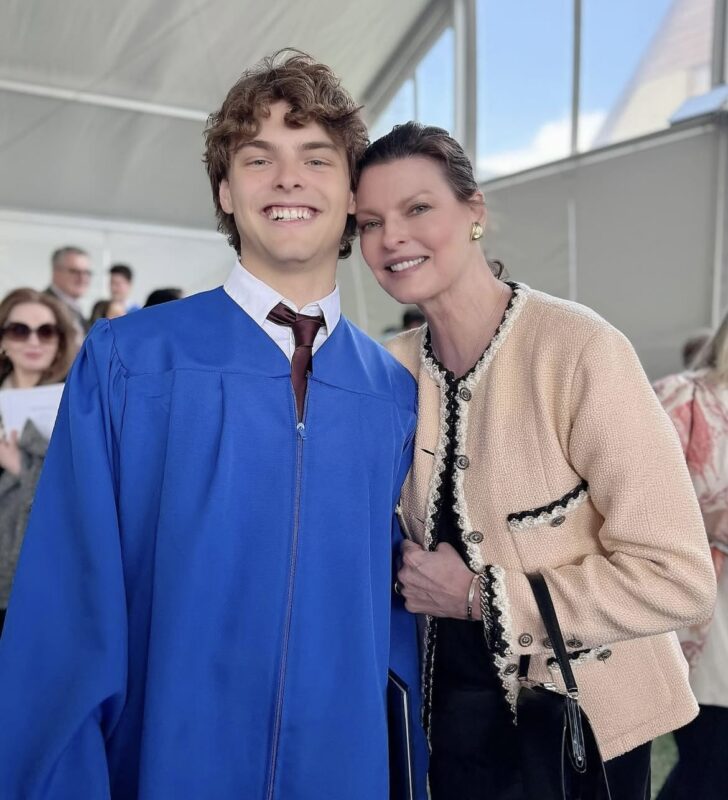
Linda Evangelista at her son’s graduation on June 3, 2025 from Linda’s Instagram account.
Mental and Emotional Challenges
Linda Evangelista faced significant mental and emotional challenges throughout her breast cancer battle. She kept her diagnosis private for years, sharing that she did not want media intrusion during her treatment, which helped her maintain some control over her personal life. The emotional toll was profound, especially after her second diagnosis in 2022 when cancer recurred in her pectoral muscle. She described feeling “half dead” during chemotherapy and struggling with the physical and psychological effects of treatment.
Evangelista also endured severe emotional distress related to a prior cosmetic procedure (CoolSculpting) that left her permanently disfigured, adding to her mental anguish. Despite these hardships, she adopted a positive mindset, viewing her surgical scars as “trophies” symbolizing survival and strength rather than defeat. She expressed a determined attitude, telling her doctors to “dig a hole” in her chest to remove all cancerous tissue, emphasizing her will to live regardless of appearance.
The loss of close friends, such as fellow supermodel Tatjana Patitz to metastatic breast cancer, also deeply affected her. Yet, Evangelista’s resilience shines through as she embraces life with gratitude, focusing on celebration and hope despite acknowledging the seriousness of her condition. She openly encourages others to prioritize early detection and self-care, using her experience to inspire and support those facing similar battles.
How Did Advocacy and Public Awareness Help?
Linda Evangelista has used her platform to raise public awareness about breast cancer and the critical importance of early detection. In December 2023, she posted a powerful mammogram selfie on Instagram during Cancer Screening Week, openly sharing her experience as a two-time breast cancer survivor to encourage others to prioritize regular screenings. She emphasized that “catching cancer or pre-cancer early can help save lives,” urging her followers to schedule cancer screening plans with their doctors.
By publicly sharing her story after years of private treatment, Evangelista has become a strong advocate for cancer awareness, inspiring many with her courage and vulnerability. Fans and followers praised her for being a “powerful voice and inspiration,” recognizing the impact of her openness in breaking stigma around cancer and motivating others to take proactive health measures.

What Is Linda Evangelista’s Life Like After Cancer?
After battling breast cancer, Linda Evangelista is embracing life with a renewed sense of self-acceptance and gratitude. She is nearing her 60th birthday and feels freer and more at peace than she has in years . While she continues to work and engage in the fashion world, her perspective on beauty has evolved .
Evangelista has undergone multiple surgeries, including a double mastectomy with small implants, liposuction, and surgeries for collapsed lungs . She now views her scars as symbols of survival and strength, stating,
“I’m cool. I’m fine with those. I won. I’m here. I won”.
She is also focusing on supporting other women and has spoken about the importance of uplifting each other . Evangelista is determined to live life to the fullest, stating,
“I’m alive. I’m alive. I’m alive, and I’m going to do what I have to do. I’m going to fight because I don’t want it any other way. I’m not done”.
Ongoing Health Challenges
Linda Evangelista continues to face ongoing health challenges following her breast cancer diagnosis and treatment. She has undergone a double mastectomy and multiple surgeries, including removal of a lump in her pectoral muscle and several lung surgeries due to collapsed lungs. Evangelista also deals with the physical aftermath of these procedures, including visible scars and keloids on her chest and back, which she now embraces as symbols of survival.
What Causes Breast Cancer?
Breast cancer is influenced by a combination of genetic, hormonal, and environmental risk factors.
Genetic and Hormonal Factors
Genetic mutations, particularly in the BRCA1 and BRCA2 genes, significantly increase breast cancer risk. Women with a BRCA1 mutation have a 55-65% chance of developing breast cancer by age 70, while those with a BRCA2 mutation have a 45% risk (National Cancer Institute, 2021). Family history is also important; having a first-degree relative with breast cancer can double a woman’s risk (American Cancer Society, 2022).Hormones, especially estrogen, play a critical role in breast cancer development. Prolonged estrogen exposure, such as starting menstruation before age 12 or entering menopause after age 55, can elevate risk (World Health Organization, 2019). Additionally, hormone replacement therapy (HRT) may increase breast cancer risk by 26% (JAMA Oncology, 2019).
You Can Also Read Bianca Balti: The Supermodel’s Brave Battle with Ovarian Cancer by Oncodaily
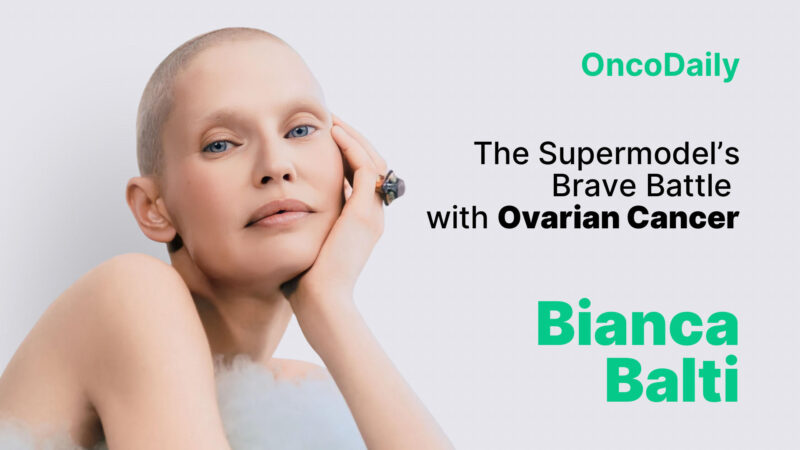
Lifestyle and Environmental Factors
Diets high in saturated fats and low in fruits and vegetables increase the risk of breast cancer, while obesity, particularly after menopause, is also linked to a higher risk (American Cancer Society, 2022). Regular alcohol consumption further raises this risk, with women who drink more than one alcoholic beverage daily having a 20-25% higher chance of developing breast cancer (National Cancer Institute, 2021).
Additionally, a lack of physical activity contributes to obesity and hormonal imbalances, further increasing risk, while regular exercise provides protective benefits. Environmental pollutants, such as pesticides, have also been associated with a heightened breast cancer risk (Environmental Health Perspectives, 2019). Radiation exposure, especially to the chest area during youth, is another well-established risk factor (World Health Organization, 2019). Together, these factors highlight the importance of lifestyle choices and environmental awareness in breast cancer prevention.
How Can Breast Cancer Be Prevented?
Regular mammograms and other screening methods are vital for the early detection of breast cancer, significantly improving treatment outcomes and survival rates.In addition to regular screenings, specific lifestyle changes can significantly lower the risk of developing breast cancer.
Regular Screenings and Early Detection
BRCA mutations in the BRCA1 and BRCA2 genes significantly raise the risk of breast and ovarian cancers, with women facing up to an 85% lifetime risk for breast cancer and 40-60% for ovarian cancer. Preventive options include increased screening, risk-reducing surgeries like prophylactic mastectomy and salpingo-oophorectomy, medications, lifestyle changes, and genetic counseling.
Many individuals opt for surgeries to lower their cancer risk, and the National Cancer Institute outlines the benefits of these options. Additionally, some may choose chemoprevention with medications such as tamoxifen or aromatase inhibitors, which can reduce breast cancer risk, as noted by the Mayo Clinic.
Women aged 40 and older should have annual mammograms, as early detection through mammography can identify breast cancer before symptoms develop, leading to less invasive treatments. The American Cancer Society reports a 5-year survival rate of 99% for localized breast cancer, compared to just 29% if diagnosed at a later stage (American Cancer Society, 2021). Regular mammography can reduce breast cancer mortality by approximately 15-30% among women aged 40-74 (U.S. Preventive Services Task Force, 2016). Prioritizing screenings allows women to catch breast cancer early, resulting in more effective treatments and better outcomes.
You Can Also Read Immunotherapy for Breast Cancer: Types, Success Rate, Side Effects & More by Oncodaily
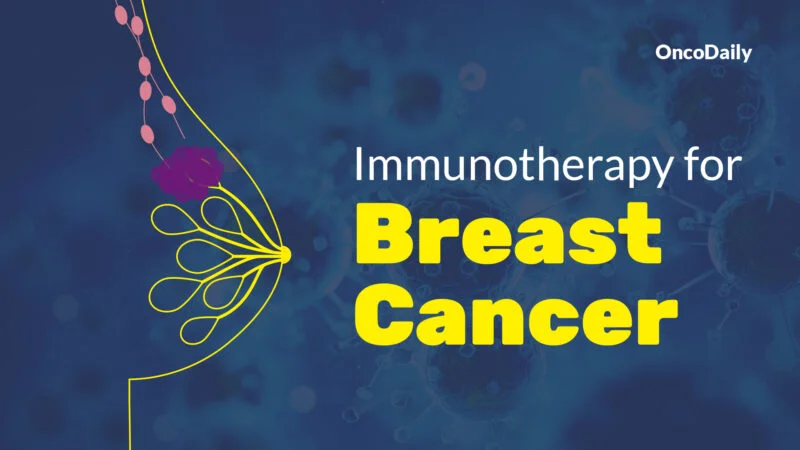
Lifestyle Changes
A healthy diet is vital for reducing breast cancer risk, focusing on fruits, vegetables, whole grains, and lean proteins. Research indicates that women with a diet high in fruits and vegetables have a 20% lower risk of breast cancer (American Institute for Cancer Research, 2018). Regular exercise is also important; at least 150 minutes of moderate aerobic activity weekly can reduce breast cancer risk by about 25% (National Cancer Institute, 2020).
Limiting alcohol intake is crucial, with recommendations of no more than one drink per day. Consuming two to three drinks daily increases the risk of breast cancer by 20-30% (American Cancer Society, 2021). Maintaining a healthy weight is essential, as obesity raises the risk by 30-60% in postmenopausal women (World Health Organization, 2020). Lastly, avoiding tobacco is key; women who smoke are 25% more likely to develop breast cancer compared to non-smokers (Cancer Research UK, 2019).
Written by Aharon Tsaturyan MD
FAQ
How Did Linda Evangelista Get Diagnosed with Breast Cancer?
Linda Evangelista was diagnosed in December 2018 after a routine mammogram revealed abnormal results. Further imaging and a biopsy confirmed breast cancer, highlighting the importance of regular screenings.
What Was the Prognosis?
Her prognosis was challenging due to a high risk of recurrence, as indicated by a poor Oncotype DX score. Despite aggressive treatment, she experienced a recurrence in 2022, but ongoing medication and monitoring are helping to reduce further risk.
What Treatments Did Linda Evangelista Undergo for Breast Cancer?
She had a bilateral mastectomy after her initial diagnosis, followed by surgery, chemotherapy, and radiation therapy for a recurrence in 2022. She continues to take medication to lower the risk of future recurrence.
How Did Linda Evangelista Overcome Breast Cancer?
Evangelista faced her diagnosis with determination, opting for aggressive treatment and viewing her scars as symbols of survival. She maintains a positive outlook and shares her story to inspire others.
Who Supported Linda Evangelista During Her Cancer Battle?
While she keeps her personal life private, Evangelista has credited her close family, children, and friends for providing emotional support and motivation throughout her treatment.
What Mental and Emotional Challenges Did She Face?
She struggled with the emotional toll of cancer, chemotherapy, and a prior cosmetic procedure that left her disfigured. Despite these hardships, she adopted a mindset of resilience and self-acceptance.
How Did Advocacy and Public Awareness Help?
Evangelista used her platform to encourage early cancer screenings, sharing her story publicly to inspire others and raise awareness about the importance of early detection.
What Is Linda Evangelista’s Life Like After Cancer?
She embraces life with gratitude, focusing on self-acceptance and supporting other women. Despite ongoing health challenges, she is determined to live fully and advocate for cancer awareness.
What Causes Breast Cancer?
Breast cancer is caused by a mix of genetic (like BRCA mutations), hormonal, lifestyle, and environmental factors. Family history, hormone exposure, diet, alcohol, obesity, and environmental pollutants all play roles.
How Can Breast Cancer Be Prevented?
Prevention includes regular mammograms, a healthy diet, regular exercise, limiting alcohol, maintaining a healthy weight, not smoking, and considering genetic counseling if at high risk.
What are the common signs and symptoms of breast cancer?
Breast cancer may present as a lump in the breast, changes in breast shape or size, skin dimpling, nipple discharge, or redness and swelling. Early detection through mammograms is crucial as symptoms may not always be obvious.
What are the risk factors for developing breast cancer?
Risk factors include family history of breast or ovarian cancer, inherited gene mutations (such as BRCA1 and BRCA2), age (50+), hormonal factors, obesity, radiation exposure, and certain ethnic backgrounds. However, most breast cancers occur in women without a family history.
How can breast cancer be prevented or detected early?
Prevention strategies include maintaining a healthy lifestyle (diet, exercise, limiting alcohol), regular screening mammograms starting at recommended ages, genetic counseling if at risk, and awareness of breast changes. Early detection significantly improves survival rates
